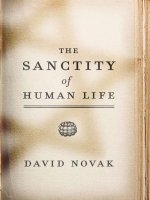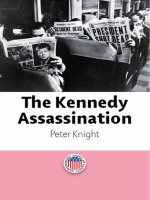rutgers university press the george washington bridge poetry in steel oct 2008
Bạn đang xem bản rút gọn của tài liệu. Xem và tải ngay bản đầy đủ của tài liệu tại đây (2.59 MB, 196 trang )
Other Works by Michael Aaron Rockland
Nonfiction
Sarmiento’s Travels in the United States in 1847 (1970)
America in the Fifties and Sixties: Julian Marias on the United States
(editor) (1972)
The American Jewish Experience in Literature (1975)
Homes on Wheels (1980)
Looking for America on the New Jersey Turnpike (co-authored with
Angus Kress Gillespie) (1989)
Snowshoeing Through Sewers (1994)
What’s American About American Things? (1996)
Popular Culture: Or Why Study “Trash”? (1999)
The Jews of New Jersey: A Pictorial History (co-authored with
Patricia M. Ard) (2001)
Fiction
A Bliss Case (1989)
Screenplay
Three Days on Big City Waters (co-authored with Charles Woolfolk)
(1974)
00a_FMatter_i-x_10 6/23/08 3:57 PM Page i
00a_FMatter_i-x_10 6/23/08 3:57 PM Page ii
TheGeorgeWashingtonBridge
Poetry in Steel
Michael Aaron Rockland
Rivergate Books
An imprint of Rutgers University Press
New Brunswick, New Jersey, and London
00a_FMatter_i-x_10 6/23/08 3:57 PM Page iii
Library of Congress Cataloging-in-Publication Data
Rockland, Michael Aaron.
The George Washington Bridge : poetry in steel / Michael Aaron Rockland.
p. cm.
Includes bibliographical references and index.
ISBN 978–0–8135–4375–8 (hardcover : alk. paper)
1. George Washington Bridge (New York, N.Y.) 2. Bridges—New York (State)—
New York—Design and construction—History. I. Title.
TG25.N515R63 2008
624.2'3097471—dc22
2008000897
A British Cataloging-in-Publication record for this book is available from the British
Library.
Title page photograph courtesy of the Port Authority.
Copyright © 2008 by Michael Aaron Rockland
All rights reserved
No part of this book may be reproduced or utilized in any form or by any means,
electronic or mechanical, or by any information storage and retrieval system, without
written permission from the publisher. Please contact Rutgers University Press,
100 Joyce Kilmer Avenue, Piscataway, NJ 08854–8099. The only exception to this
prohibition is “fair use” as defined by U.S. copyright law.
Visit our Web site:
Manufactured in the United States of America
Design and composition: Jack Donner, BookType
00a_FMatter_i-x_10 6/23/08 3:57 PM Page iv
For Alana, Jessica, Jacob, Talia, Shira, Maliwan, and Jangila
The Future Is Now
00a_FMatter_i-x_10 6/23/08 3:57 PM Page v
00a_FMatter_i-x_10 6/23/08 3:57 PM Page vi
“The George Washington .
is the most beautiful bridge in the world”
—Le Corbusier
00a_FMatter_i-x_10 6/23/08 3:57 PM Page vii
00a_FMatter_i-x_10 6/23/08 3:57 PM Page viii
Introduction 3
1 A Day on the G.W.B. 13
2 The George and the Brooklyn: New Jersey and New York 27
3 Othmar Ammann 39
4 Building the Bridge 55
5 The Accidental Icon 69
6 “The Martha” and the Bus Station 81
7 Dramas, Dangers, and Disasters 93
8 The George Washington Bridge in Literature 107
9 The George Washington Bridge in the Other Arts 123
10 Life Along the Walkways 135
11 The G.W.B. and Me 147
Acknowledgments 155
Notes 159
Selected Bibliography 175
Index 179
Contents
ix
00a_FMatter_i-x_10 6/23/08 3:57 PM Page ix
00a_FMatter_i-x_10 6/23/08 3:57 PM Page x
The George Washington Bridge
00b_Intro_1-11_11 6/23/08 3:57 PM Page 1
The world from on high in one of the towers. Courtesy of the Port Authority.
00b_Intro_1-11_11 6/23/08 3:57 PM Page 2
I
have lived most of my life on one side or the other of the
George Washington Bridge. It is the busiest bridge in the world and,
since its 1931 inauguration, has gotten steadily busier. Some 108 million
vehicles crossed it in 2007, utilizing its two decks and fourteen lanes.
Many people have deep affection for it and consider it the most beau-
tiful bridge in the world. The George Washington, which celebrated its
seventy-fifth anniversary in 2006, is in a class of its own.
When I was a young boy growing up in the Bronx, I knew about the
bridge because vegetable-laden horse-drawn wagons, having crossed it
from New Jersey, regularly wandered through my Bronx neighborhood.
Cries were directed up to the windows of each apartment building:
“New Jersey fresh; New Jersey fresh.” My mother would lean out the
window and tell the farmers what she wanted and then, grabbing her
pocketbook, go downstairs to complete the purchases. Egg vendors also
came across the bridge from New Jersey and went door-to-door in our
building. My mother bought from them too. “Direct from the hen,” she
would say. In those days it seemed perfectly valid for New Jersey to call
itself “the Garden State.” And for New Yorkers, the pathway to that
garden’s bounty was the George Washington Bridge.
My father would often talk about being at the George Washington as
a pedestrian when it opened for traffic on October 25, 1931. That day
57,788 vehicles and one man on a horse crossed the bridge. Tolls for
automobiles and horse-and-wagons were an identical fifty cents, but the
policemen who were then the toll collectors were unsure whether to
Introduction
3
00b_Intro_1-11_11 6/23/08 3:57 PM Page 3
charge the man on horseback fifty or the twenty-five charged for bicy-
cles. After some discussion, they elected the latter. Ten cents was
charged for pedestrians on the walkways, though the shuttle bus ride
across the bridge was only a nickel.
Years later my father was still commenting on this irony. “It cost more
to walk across it than to ride the bus across it,” he would say indignantly.
He always planned to write the Port Authority to complain. Perhaps he
did, because eventually the pedestrian toll dropped to a nickel and later
4 The George Washington Bridge
Photo of the author (on right) at age five on the George
Washington Bridge, his older brother on the left.
00b_Intro_1-11_11 6/23/08 3:57 PM Page 4
was abandoned altogether, while the fare for the bus went up steadily
and today is a dollar. My father, as if he had a proprietary interest in it,
followed all news of the George. For him, it was the bridge.
As it was for my boyhood friends and me. We often took a trolley to
the Bronx’s limits on the Harlem River and trekked across this skinny
portion of Manhattan, which here, between the Harlem and Hudson
rivers, is only a mile and a quarter wide. We would access one of the
two bridge walkways that flank the Upper Level and begin hiking to
New Jersey. We could see the great buildings of Manhattan stretching
to the south and the dark Palisades of New Jersey directly to the west.
The sparkling Hudson rushed by beneath us, with far more river traffic
than you see today—tugs and freighters and oil barges and pleasure
boats—but our eyes were especially drawn, directly in front of us, to
the lattice-like steel girders of the giant bridge towers.
The towers reminded us of our Erector Set projects. Indeed, from
the moment the George Washington Bridge was inaugurated in 1931
the picture on Erector Set boxes was of a father and son working
together on a miniature G.W.B. tower with a painting of the bridge
itself in the background. The message was clear: when they grew up,
those with Erector Sets would do great things. Dr. Margot Ammann
Durrer, daughter of Othmar Ammann, remembers her father, years
after he had designed and built the George Washington Bridge,
“constructing a model of a G.W.B. tower with my brothers using their
Erector Set.”
1
My own father and I—like Ammann and his sons and
the father and son on the box—tried to make a George Washington
Bridge tower with the Erector Set he had bought me for my birthday.
Eventually, we gave up because the project was so complicated. No
other bridge has such complex and interesting towers. As we shall see
in chapter 5, “The Accidental Icon,” there is quite a story behind why
the towers look as they do.
Hiking toward the towers, my friends and I were alternately
thrilled and frightened as our walkway bounced up and down in
response to traffic and weather. The bridge’s roadways can oscillate by
as much as three feet. The giant barrel cables from which they hang,
two on the north side and two on the south, bow slightly under the
weight. Motorists on the bridge, especially on warm summer days
when steel expands, nervously notice this effect whenever congestion
brings traffic to a halt. Is something the matter with their car? Why
is it bouncing so jerkily? What if they break down on the George
Introduction 5
00b_Intro_1-11_11 6/23/08 3:57 PM Page 5
Washington Bridge? Few realize that the bridge itself is making their
car act strangely. But no matter: once they’re off the bridge and those
strange movements cease, a trip to the mechanic is put off and even-
tually forgotten.
The bridge for my friends and me didn’t just move, it made sounds.
The wind buffeting the towers and cables caused them to emit strange
noises. David Shayt, of the National Museum of American History, says
the sounds remind him of those produced by a tuning fork, but the
image my friends and I entertained was of a giant harp.
2
That “harp,”
like any suspension bridge, seemed like a goofy Rube Goldberg concoc-
tion designed to defy gravity. Wasn’t there a simpler way to build a
bridge, we wondered, than to erect towers that touch the sky, run what
appear to be giant clotheslines over them, and then hang roadways off
the lines?
After my friends and I crossed the George to the New Jersey side, we
would camp out in the woods on the crest of the Palisades in the Fort
Lee area, not yet covered with high-rise apartment buildings. Few
people today think about a fort when they say “Fort Lee,” but what is
now a small city was an important fort during the American Revolution.
Fort Lee was named for General Charles Lee, second in command of
the American army. Thomas Paine, then an aide to General Nathanael
Greene, who commanded the 2,667 troops stationed there, wrote the
inflammatory pamphlet The American Crisis at the fort, with its crucial
line “These are the times that try men’s souls” and its famous references
to “summer soldiers” and “sunshine patriots.”
A disconsolate George Washington stood in Fort Lee in November
1776 watching the British surround and capture Fort Washington on
the New York side of the Hudson in the area of Manhattan we now
call Washington Heights. While he held both forts, Washington could
control access to the Hudson River with cannon. But with the bulk of
his bedraggled army he had been forced to escape across the Hudson
to Fort Lee at almost exactly the spot where the bridge that bears his
name now stands. Soon he would also abandon Fort Lee and retreat
across New Jersey and into Pennsylvania, the British in hot pursuit.
The Revolutionary War was at a desperate stage at this point, with
one American defeat after another. Hungry for some kind of victory,
however humble, Washington, by late December, would recross the
Delaware, cleverly circumvent the main British army, and defeat the
Hessians at Trenton, following this by defeating another minor force of
6 The George Washington Bridge
00b_Intro_1-11_11 6/23/08 3:57 PM Page 6
enemy troops occupying Princeton. He would be back in Fort Lee in
1781, preparing to cross the Hudson again to engage the British in
Manhattan.
Thus the George Washington Bridge stretches from one Revolu-
tionary War fort site to another. The New York tower stands in Fort
Washington Park, the New Jersey tower just offshore from where Fort
Lee once stood on the Palisades. At the G.W.B.’s inauguration on
October 24, 1931, New York governor Franklin Roosevelt—soon to be
president of the United States—said, “We may rejoice that this bridge
is at a site so sacred to patriotic memories.”
3
But for my friends and me, city boys, crossing the bridge to Fort Lee
was simply going to “the country.” In the woods of Palisades Interstate
Park, accessible from the north walkway, we would make a fire and cook
skewers of meat and apples and onions. As evening came on and the sun
sank behind us, we observed the color of the bridge changing from silver
to purple to orange. When we awoke in our pup tents in the morning,
there the bridge still was, the sun, as it rose in the east, placing the
towers in silhouette while the great city across the Hudson came alive.
Though we were too young to express it in this manner, we marveled at
the scene the bridge presented of the built environment and nature
combining so harmoniously.
Most of my adult life has been spent on the New Jersey side of the
bridge. The bridge has been, in a sense, an indispensable link between
my two selves—as much metaphor as means of crossing the Hudson. I
have traversed it numerous times on foot and by bicycle and perhaps a
thousand times by automobile.
Often I have elected the bridge even when it would have been more
convenient to take the Holland or Lincoln Tunnel en route to midtown
or Lower Manhattan to see a play, attend a concert, or check out an art
exhibit. Bridges, especially the George Washington, make me happy.
They express in physical form one of the noblest impulses of mankind—
to reach across barriers. I approach a bridge with anticipated pleasure.
George Bailey, played by Jimmy Stewart in the movie It’s a Wonderful
Life, was speaking to me when he reasserted his belief in life by saying,
“I’m going to build things. . I’m going to build bridges a mile long.”
4
While recognizing tunnels as a technological achievement, I don’t
feel the same way about them. In tunnels I’m anxious to get to the other
end—only beginning to relax when I see a distant light beckoning—
whereas on a bridge I drive as slowly as I dare to prolong the experience.
Introduction 7
00b_Intro_1-11_11 6/23/08 3:57 PM Page 7
Bridges soar; tunnels burrow. As John Teel, a retired electrician who
spent most of his working years on the G.W.B., once said to me, “A
bridge is like an airplane. A tunnel is a hole in the ground.”
5
The George Washington was also for many years my path to twice-
monthly visits to my aged mother, still living in the old Bronx
neighborhood. From my mother’s balcony, looking west, I could see the
gleaming towers of the bridge I had driven across shortly before. They
were as tall as sixty-story skyscrapers and even more imposing, standing
astride the Hudson River on their great legs. From that perspective the
towers were not only spectacular; they had an ominous quality. They
reminded me of the Martian war machines in H. G. Wells’s War of the
Worlds, which in Orson Welles’s 1938 radio version marched across
New Jersey. It was as if the towers had done just that and now were hesi-
tating, one having forded the great river, the other as yet uncertain
whether to proceed.
It was usually dark on my return trip to New Jersey, and I would
anticipate with pleasure the double necklace of 148 emerald-green
mercury-vapor lights that decorates the two outside barrel cables. The
lights were extinguished during World War II because they made the
bridge a perfect target for aerial attack. Destroying the G.W.B. then, as
now, would have crippled the metropolitan area because it was and
remains the only bridge directly connecting New Jersey and the conti-
nent beyond to Manhattan Island. I would also look forward to seeing
the bright Will Rogers–Wiley Post beacon whose beam extends out
sixty-four miles from atop the New York tower and has guided planes
into Greater New York’s airports since 1935.
6
Before 2000 the towers themselves were illuminated from below by
searchlights, but in celebration of the millennium, they were ingeniously
lit from within, each with 380 1,000-watt lights, some say in imitation
of the Eiffel Tower in Paris but, for me, more beautiful given their
dramatic setting. Those crystalline lights were turned on for the first
time at sunset on July 4, 2000. Now, on national holidays, they glow
brightly from the towers, making them appear to be encrusted with
diamonds. The bridge is beautiful by day; by night the George is
magical.
In New Jersey and New York, we’re all on a first-name basis with “the
George,” a.k.a. “the G.W. Bridge,” “the G.W.B.,” “the G.W.,” and “the
Geo.” For some of us—especially people in the Bronx, Upper
Manhattan, and New Jersey, not to mention truckers and other motorists
8 The George Washington Bridge
00b_Intro_1-11_11 6/23/08 3:57 PM Page 8
embarking on or terminating a transcontinental trip—it’s simply “the
bridge,” like New York is “the city.” The famed Brooklyn Bridge is hardly
on our radar screens.
Nevertheless, when I visited my public library a few years ago
seeking a book on the George Washington, I found none. I wanted to
read up on the bridge, to find out more about who built it, how it
worked—not just to enjoy it but to understand it, nuts and bolts. The
library had a whole section of books on bridges, some going back to
the very earliest—those nature created when trees fell across rivers,
others that native peoples spun with fibers across gorges in the Andes,
two-thousand-year-old Roman bridges that still stand. I counted no
fewer than five books on the Brooklyn Bridge, one on the Triborough
Bridge, and another on the Verrazano, just to mention bridges around
New York City. Many of the general books by bridge aficionados
contained chapters on the George Washington, but there was no book
on the George itself. I checked my county library with the same
results. I checked the library of the university where I teach; I went
online. Again, no luck. I couldn’t quite believe it. I had always thought
the George to be as important, not just from an engineering perspec-
tive but culturally and historically and aesthetically as well, as any
bridge in the world.
7
I decided that if I really wanted to know about
the George Washington Bridge I would have to research and write the
book myself.
But writing a book about it in today’s world is easier said than done.
The 1993 bombers of the World Trade Center had the George Wash-
ington Bridge on their list for future terrorist attacks. And when 9/11
happened eight years later, the Port Authority of New York and New
Jersey tragically lost eighty-four of its personnel, some of whom would
have had much to tell me about the bridge. The Authority also lost the
greater part of its eighty years (1921–2001) of archives and old
photographs when the Twin Towers, where it was headquartered, and
which it financed and managed, were destroyed.
Security issues in our post-9/11 world played an important role in the
writing of this book. Even though earlier in my career I had a top secret
clearance from the federal government, it took four months before I
was vetted by the Port Authority, and even then I was aware that on the
bridge I was under surveillance. Someone hanging out on the bridge
walkways is, understandably, regarded suspiciously; there are signs
everywhere that say
NO LOITERING. I have in recent years, while
Introduction 9
00b_Intro_1-11_11 6/23/08 3:57 PM Page 9
studying the bridge, definitely “loitered” on it, though I have been
scrupulous in obeying the signs that say
CAMERA USE PROHIBITED—
except once, but we’ll get to that later. Martin Bruch, a handicapped
Austrian, found out the hard way that picture taking on the G.W.B. is
just not done these days. His film, Handbike Movie, details his travels
around the world on a hand-propelled adult tricycle with a camera
mounted on his helmet. When he gets to the George Washington and
attempts to ride across on the walkway, an officer stops him and forbids
him to photograph anything.
8
More than once it has occurred to me while on the bridge that secu-
rity personnel who might not know of my clearance were wondering
why I was studying the bridge so intently. If not a terrorist, was I
contemplating suicide? The G.W.B. averages slightly more than one
“successful” suicide per month and several attempts foiled by bridge
authorities taking quick action.
Eighty-six Port Authority policemen are now assigned to the bridge.
They are supported by hundreds of closed circuit television cameras on
the bridge and on the nearest high-rise buildings in Fort Lee and
Manhattan. In the lobby of the bridge offices overlooking the bridge in
Fort Lee is the Communications Center where the bridge is monitored
24/7 with the most sophisticated technology available. If you were to
pick up any of the sixty-nine emergency phones on the bridge, a camera
would immediately zoom in on you to size up the situation you might
be reporting.
Security is paramount, and it is tight. Ken Philmus, once general
manager of the G.W.B. and, on 9/11, director of the Port Authority’s
Division of Tunnels, Bridges, and Terminals, found his job consider-
ably different after the tragedy. “I’m a transportation guy,” he said.
“Now I had to devote much of my time and our resources to security.
And security is one big toilet bowl; you get nothing positive out of it.”
9
The Authority spends half a billion dollars more per year on security
for its bi-state facilities—its bridges and tunnels and airports and
trains and the port itself—than it was spending before 9/11.We’ddo
well to remember that when we complain about increased tolls and
fees.
Despite heightened security, I was granted two opportunities to expe-
rience the most sensitive and interesting places on and around the
bridge. It is one thing as a writer to gather the facts about a subject,
quite another to clamber about on it—to know it quite literally top to
10 The George Washington Bridge
00b_Intro_1-11_11 6/23/08 3:57 PM Page 10
bottom rather than just reading everything available and interviewing
knowledgeable people about it. Thus this book combines scholarship on
the one hand and adventure on the other. Something of the personal
intrudes in virtually every chapter—in part because of my affection for
the bridge and a lifetime of experiencing it but also because of the days
on the bridge to which authorities treated me. The first of these follows
as chapter 1.
Michael Aaron Rockland
Morristown, New Jersey
February 2008
Introduction 11
00b_Intro_1-11_11 6/23/08 3:57 PM Page 11
The bridge in fog in 1962, the Lower Level now in place. Courtesy of the Port
Authority.
01_Day_12-25_14 6/23/08 3:58 PM Page 12
O
n April 11, 2006, Robert Durando, general manager of the
George Washington Bridge, and Robert McKee, physical plant
manager, took me on a tour of bridge facilities the public never sees,
some of which I didn’t know existed. As general manager, Durando
supervises some 220 full-time staff members (not including the 86
bridge police) while McKee, one of two key assistants to Durando (the
other is concerned with daily operations such as toll collecting),
manages regular and long-range maintenance.
It was Opening Day at Yankee Stadium, and Durando and McKee
had agreed to accompany me in the hours after New Jersey fans had
already passed over the bridge and before they would be coming back
from the Bronx. We could hear fighter jets tearing through the sky over
the Bronx, part of the Opening Day festivities. When the Yankees are
playing a home game, the bridge staff is on alert. McKee told me, “We
coordinate bridge operations as well as repairs and construction not just
around the Yankees’ schedule but also around the Jets and Giants and
special events at the Jersey Meadowlands such as Bruce Springsteen
concerts.”
1
Durando and McKee worked together in their previous jobs,
Durando as general manager and McKee as physical plant manager at
the Holland Tunnel. McKee says, “When something comes up, Bob and
I know exactly what the other guy is thinking and what to do.” During
my hours with them the two Bobs were regularly on their BlackBerrys
1
A Day on the G.W.B.
13
01_Day_12-25_14 6/23/08 3:58 PM Page 13
responding to phone calls and text messages from bridge offices and
Port Authority headquarters in Manhattan, which made me feel less
guilty about taking them away from their desks.
Bob Durando worked his way up to top man at the George Wash-
ington starting out as a temporary toll collector at the Port Authority’s
three Staten Island bridges—the Goethals, Bayonne, and Outerbridge
Crossing. “The culture I grew up in was different,” he says. “You started
a job somewhere and stayed with it and moved up in the ranks. Young
people today jump around from job to job. I wonder if they have the
same satisfaction, feel the pride. Every day I wake up and remind myself
that I’m steward of the most important bridge in the world.”
Bob McKee considers himself “second generation Port Authority.”
His father was working for the Authority when he was born; later, they
overlapped. As he puts it, “I’ve been in the Port Authority and it’s been
in me all my life. This isn’t just my job.” McKee says he works for
“Mother
PONYA,” the second part of which stands for “Port of New York
Authority”—the Authority’s original name. “We think of the Port
Authority facilities as our other mother,” McKee says, “and we take good
care of her. It may sound corny, but the seven thousand people working
for the Authority think of themselves as a family.”
Both men love the bridge. Each lives at least an hour away in New
Jersey and gets up at 5:00 a.m. to begin his workday. By 6:30 they’re at
their desks in the G.W.B. Administration Building overlooking the
bridge in Fort Lee. Normally they work at least ten-hour days; in emer-
gencies they don’t go home. They’re on call 24/7. When I’ve e-mailed
them on weekends, expecting to get a response on Monday, they’ve
often answered in minutes via their BlackBerrys. “Yeah, I take it with me
golfing,” Durando says. When they’re not in their offices and something
significant happens at the bridge, even if they could handle it from
home, they drive in. McKee says, “I tell my staff, ‘If you work at the
G.W. you’re in the major leagues. And I’m the team manager; I’ve got
to be here. If something happened to this bridge and I wasn’t here, I
couldn’t live with myself.”
During my many visits to the bridge and its offices, I found deep
affection for the George Washington and universal pride among the
staff. Indeed, those who work at the bridge and, to accept a promotion,
must transfer to another Port Authority facility do so with mixed feel-
ings. Steve Napolitano, who served as general manager of the George
Washington Bridge from 1997 to 2002 and is now assistant director of
14 The George Washington Bridge
01_Day_12-25_14 6/23/08 3:58 PM Page 14
the Port Authority’s Division of Tunnels, Bridges, and Terminals, says,
“People who work at the bridge wouldn’t work anywhere else if the
choice was theirs. There’s a special bond among G.W.B. people. They’re
like a fraternity.”
2
Ken Philmus, another general manager who had been promoted off
the bridge, was driving across it with his wife one day when she said,
“Kenny, why are you looking so sad?”
“It’s not my bridge anymore,” he answered.
“Don’t worry,” his wife said, “it’ll always be your bridge.”
3
Jerry Del Tufo was the physical plant manager at the G.W.B. before
he was promoted to general manager of the three Port Authority Staten
Island bridges. “I miss the George,” he says. “I talked about it so much
when I was here that when my mother learned I was transferred to
Staten Island she said, ‘Whatsamatta with you? You got demoted?’”
4
Del Tufo and Robert Eadicicco, formerly operations manager at the
G.W.B. and now general manager of the Holland Tunnel, occasionally
meet Bob Durando for breakfast at the Red Oak Diner in Fort Lee.
Afterward, the three men light up cigars and take a just-after-sunup
stroll across the George on the walkway before each heads to his
present job site. “We’re G.W.B. junkies,” Del Tufo says. “We can’t stay
away from the bridge. When I left here, a chunk of myself remained
behind.”
Bob Durando, Bob McKee, and I began our tour of the bridge on the
south walkway heading east toward the New Jersey tower. We passed the
monument to Bruce Reynolds, one of the thirty-seven Port Authority
police officers who died on 9/11 at the World Trade Center and the only
one whose regular assignment was the G.W.B. A small contingent of
bridge patrolmen was sent down to the site, the rest remaining behind
to manage the transportation crisis occasioned by the closing of the
bridge and to guard against attempts on the structure itself. A picture
of Reynolds is engraved in polished black granite above the legend
THE
FACE OF A HERO
/ HE GAVE HIS LIFE FOR AMERICA / YOU ARE IN
OUR HEARTS FOREVER
. People still regularly leave flowers and flags
beneath the stone.
In Fort Lee, Bridge Plaza South, on which the G.W.B. offices are
located, has been renamed Bruce Reynolds Boulevard. To get to the
entrances to the north and south walkways, you follow the signs on the
boulevard down to Hudson Terrace. Toward the bottom of Bruce
A Day on the G.W.B. 15
01_Day_12-25_14 6/23/08 3:58 PM Page 15









